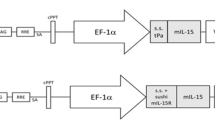Abstract
We evaluated the antitumor effect of an interleukin 2 (IL-2) slow delivery system, the IL-2 mini-pellet, in two murine solid tumor models, and also investigated the enhancement of its therapeutic effect by serial administration. The IL-2 mini-pellet contains 1 × 106 units of IL-2 and releases it slowlyin vivo. In our experiment, the IL-2 mini-pellet was administered subcutaneously near the tumor site in combination with the intravenous injection of lymphokine-activated killer (LAK) cells. When this regimen was given on days 8 and 11 after the subcutaneous inoculation of Meth A fibrosarcoma into BALB/c mice, tumor growth was significantly inhibited (p < 0.05) compared to tumor growth in untreated controls. Moreover, the IL-2 mini-pellet alone was also effective in inhibiting tumor growth. In another experiment, MH134 hepatoma was inoculated into C3H/He mice. Both administration of the IL-2 minipellet alone and in combination with LAK cells resulted in complete tumor regression in four of five mice. In a third experiment, serial administration of the IL-2 mini-pellet at 3- or 5-day intervals prolonged the suppression of Meth A fibrosarcoma growth in BALB/c mice. These results suggested that the IL-2 mini-pellet could be applied to cancer immunotherapy and that its antitumor effect could be prolonged by serial administration.
Similar content being viewed by others
Abbreviations
- IL-2:
-
interleukin 2
- LAK:
-
lymphokine-activated killer
- NK:
-
natural killer
- CTL:
-
cytotoxic T lymphocytes
- BRM:
-
biological response modifiers
- VLS:
-
vascular leak syndrome
- DDS:
-
drug delivery system
References
Morgan DA, Ruscetti FW, Gallo G. Selectivein vitro growth of T lymphocytes from normal human bone marrows. Science 1976; 193: 1007.
Sayers TJ, Mason AT, Ortaldo JR. Regulation of human natural killer cell activity by interferon-γ: lack of a role in interleukin-2-mediated augmentation. J Immunol 1986; 136: 2176.
Shaw J, Caplan B, Paetkau LM, Delovitch TL, Mckenzie IFC. Cellular origins of co-stimulator (IL-2) and its activity in cytotoxic T lymphocyte responses. J Immunol 1980; 124: 2231–39.
Taniguchi T, Matsui H, Fujita T, Takaoka C, Kashima N, Yoshimoto R, Hamuro J. Structure and expression of a cloned cDNA for human interleukin 2. Nature 1983; 302: 305.
Grimm EA, Mazumder A, Rosenberg SA. Lymphokineactivated killer phenomenon. Lysis of natural killer-resistant fresh solid tumor cells by interleukin 2-activated autologous human peripheral blood lymphocytes. J Exp Med 1982; 155: 1823–41.
Rosenberg SA, Lotze MT, Maul LM, Chang AE, Avis FP, Leitman S, Linehan WN, Robertson CN, Lee RE, Rubin JT, Seipp CA, Simpson CG, White DE. A progress report on the treatment of 157 patients with advanced cancer using lymphokine activated killer cells and interleukin 2 or high-dose interleukin 2 alone. N Eng J Med 1987; 316: 889–97.
Rosenstein M, Ettinghausen SE, Rosenberg SA. Extravasation of intravascular fluid mediated by the systemic administration of interleukin 2. J Immunol 1986; 137: 1735–42.
Matsuoka J, Sakagami K, Shiozaki S, Uchida S, Fujiwara T, Gohchi A, Orita K. Development of an interleukin 2 slow delivery system. Trans ASAIO 1988; 34: 729–31.
Takenaka H, Fujioka K, Takada Y. New formulations of interferon. Proc Cont Rel Bio Mat 1986; 71–2.
Hank JA, Kohler PC, Hillman GW, Rosenthal N, Moore KH, Storer B, Minkoff D, Bradshaw J, Bechhofer R, Sondel PM.In vivo induction of the lymphokine-activated killer phenomenon: Interleukin 2 dependent human non-major histocompatibility complex-restricted cytotoxicity generatedin vivo during administration of human recombinant interleukin 2. Cancer Res 1988; 48: 1965–71.
Deodhar SD, Barna BP, Chiang T. Inhibition of lung metastases by liposomal immunotherapy in a murine fibrosarcoma model. J Biol Resp Modif 1982; 1: 27–34.
Ono M, Tanaka N, Orita K. Complete regression of mouse hepatoma transplanted after partial hepatectomy and immunological mechanism of such regression. Cancer Res 1986; 46: 5049–53.
Author information
Authors and Affiliations
Rights and permissions
About this article
Cite this article
Fujiwara, T., Sakagami, K., Matsuoka, J. et al. Augmentation of antitumor effect on syngeneic murine solid tumors by an interleukin 2 slow delivery system, the IL-2 mini-pellet. Biotherapy 3, 203–209 (1991). https://doi.org/10.1007/BF02171683
Received:
Accepted:
Issue Date:
DOI: https://doi.org/10.1007/BF02171683




